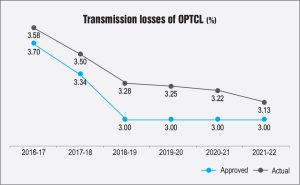Odisha Power Transmission Corporation Limited (OPTCL) is a progressive power utility in the eastern region, with a transmission network of 15,707 ckt. km and transformation capacity of 24,403.5 MVA, as of March 2022. It has been one of the front runners among transmission utilities in embracing the latest technologies. It has successfully implemented supervisory control and data acquisition (SCADA)-based automated systems, automatic demand-side management systems, a geographic information system (GIS), advanced metering infrastructure (AMI), a primary data centre (PDC), information security management system (ISMS) and remote surveillance, among others. Further, the utility has established a robust optical ground wire (OPGW) communication backbone of 6,020 km to support all its information technology (IT) and operational technology (OT) applications.
Physical infrastructure and operational performance
As of March 2022, the total line length of OPTCL’s transmission network stood at 15,707 ckt. km, having increased from 13,072 ckt. km in 2016-17 at a compound annual growth rate (CAGR) of over 3.74 per cent. Of this, 51 per cent (or 8,011 ckt. km) was at the 132 kV voltage level, 41 per cent (6,499 ckt. km) at 220 kV, and the remaining 8 per cent (or 1,197 ckt. km) at 400 kV. Meanwhile, the number of substations in OPTCL’s transmission network stood at 177 in March 2022, having increased from 132 in 2016-17 at a CAGR of 6.04 per cent. Of this, 131 substations were at the 132 kV level, followed by 41 at the 220 kV level and five at the 400 kV level. In the same month, the company’s total transformation capacity stood at 24,403.5 MVA, compared to 16,535 MVA in 2016-17, having increased at a CAGR of 8.1 per cent during the period. Of the total, 9,448.5 MVA was at the 132 kV level, 11,120 MVA at the 220 kV level, and 3,835 MVA at the 400 kV level. In terms of operational performance, the transco successfully reduced its transmission losses from 3.58 per cent in 2016-17 to 3.18 per cent in 2021-22.

Financial performance
As per the latest available information, OPTCL’s total revenues for 2020-21 stood at Rs 9,044.9 million, compared to Rs 8,150.5 million in the previous year, recording a year-on-year growth of 11 per cent. Its total revenues have increased at a CAGR of 1.43 per cent over the past five years. OPTCL recorded a net profit of Rs 616.7 million during 2020-21, compared to a loss of Rs 1,443.7 million in the previous fiscal, indicating improved financial performance. OPTCL’s expenses stood at Rs 8,921.5 million during 2020-21, a marginal decline from Rs 8,954.7 million in the previous year. The total capital expenditure by the company during 2021-22 stood at Rs 6,768.7 million.

IT and OT initiatives
OPTCL, Grid Corporation of Odisha (GRIDCO), state load despatch centre (SLDC) wide area network (OGS-WAN): OPTCL has its own WAN for accessing its business applications. The WAN seamlessly integrates with various communication networks, including multiprotocol label switching (MPLS), OPGW and internet virtual private networks. The OPGW link has been commissioned at 100 locations, and internet connectivity with 100 Mbps speed is being provided to users. The IT business application has been extended to other grid substations and offices through MPLS links. MPLS links with 512 kbps of bandwidth at 72 locations, 50 Mbps of backhaul bandwidth at the head office and a 2 Mbps P2P link at one location are actively connected to the grid substations and offices of OPTCL.
AMI: OPTCL has started an AMI project to automate the process of reading the energy accounting meters installed at all interface points, as well as to build a platform for meter data collection and analysis. AMI has been implemented across 124 locations, including six powerhouses and grid substations, with a total of 846 meters. PRN files and reports are checked almost every month, and data inconsistencies observed in the PRN files, as well as data mismatches observed in the voltage reports and MW flow reports, are reported to vendors. The project will go live once the user acceptance testing is complete.
e-Shakti: OPTCL has implemented an integrated information system, called e-Shakti, for enterprise resource planning (ERP) across the organisation to ensure smooth operation through the deployment of various resources in an effective manner. The modules have been implemented for the human resources, payroll, pension, procurement, , projects, finance and energy departments. ERP enables the integration of different functional and geographically dispersed units. This results in improved decision-making in day-to-day business transactions and a reduction in transaction and coordination costs.
GIS: GIS facilitates close monitoring of transmission elements. All assets of OPTCL, such as 127 grid substations, 8,427.445 route km of lines, and 29,456 towers, have now been georeferenced under its GIS project. It mainly facilitates asset management, outage management, planning, refurbishment and expansion, and enables better decision-making through the use of geospatial information. The GIS project is also integrated with e-Shakti and Bhulekh data, enabling retrieval of real-time asset information. As part of the project, the Odisha Space Application Center has completed the survey of 17 grid substations and 2,000 towers as of March 31, 2022. The remaining survey work is in progress. A proposal has been passed for adding 33 substations, 3,600 towers and 940 route km of lines to the GIS.
Cybersecurity: OPTCL has an ISO 27001:2013 ISMS certification for its data centres as well as those of GRIDCO and the SLDC, alongside the SCADA, main control centre and backup control centre of the SLDC. OPTCL is involved in cybersecurity activities such as vulnerability assessment and penetration testing, ISMS audits and ISO certification surveillance audits.
CCTV surveillance system: For remote surveillance, 66 grid substations of OPTCL have been equipped with CCTV cameras. Through these, major equipment such as transformers, poles, isolators, switchyard boundaries, control rooms and main gates are being monitored 24×7. Installation of CCTV systems at 29 further grid substations is under progress.
PDC: OPTCL has deployed a PDC, which will serve not only OPTCL, GRIDCO and the SLDC, but also the state discoms. Colocation will help in maintaining a high level of control over the facility. Equipment and services will always be available due to system backups. All of OPTCL’s, GRIDCO’s and the SLDC’s applications have now been migrated to this PDC. This will also be helpful for effective management of IT assets. Five years after implementation, the project is currently in the operation and maintenance phase.
Other technologies implemented by OPTCL recently include the transition of its conventional grid substations to SCADA-based automated systems, and the automatic demand-side management systems rolled out for 24 grid substations to support the load balancing requirement of grid operation. Further, substation automation systems (SASs) have been implemented at 14 locations and are being implemented at 12 locations. SAS work orders have been placed for seven further locations. All of these measures will provide substantial benefits in the form of proper monitoring, ease of control, error-free operations, etc.
Challenges and the way ahead
The transco faces several challenges. An old and overloaded transmission network with frequent insulator failures, jumper and conductor snapping, and bursting of equipment such as current transformers, potential transformers and lightning arresters is a major challenge being faced by the transco. Moreover, it is facing challenges in providing adequate network to cater to the requirement of consumers from remote areas being enrolled through the Rajiv Gandhi Gramin Vidyut Yojana and Biju Gram Jyoti Yojana. Other challenges include mitigating right-of-way issues; developing a strong balance sheet for mobilisation of funds to meet the huge investment requirements in the transmission sector, including financing for unviable projects in certain areas; building a skilled work force; maintaining adequate network to cater to sudden load growth in the state; and ensuring time- and cost-efficient project completion. As OPTCL is transitioning from a closed system to an open system with several IT-OT initiatives, it is expected to be exposed to security risks and cyberthreats. Therefore, cybersecurity is also emerging as a critical challenge and needs to be addressed. Further, the modification and addition of smart equipment, alongside economic constraints, may hamper progress.
Notwithstanding these challenges, OPTCL has robust future plans. In terms of capacity addition, OPTCL expects to reach an asset base of 16,613 ckt. km of transmission lines, 25,656 MVA of transformation capacity and 194 substations by 2022-23. Further, the transco’s focus is on adopting digital technologies and automating processes with an eye on enabling ease of operation, retrieval of past data and error-free grid management. The future plan is to have a centralised control centre for all its grid substations, with backup centres in other parts of the state. Moreover, OPTCL is in the process of integrating its OT systems, that is, SAS, GIS and telecom infrastructure, with its critical infrastructure. It is also in the process of drafting cyber crisis management plan for its IT and OT infrastructure. Additionally, the SCADA/EMS systems of all SLDCs and RLDCs will be replaced under the unified load dispatch and communication project, in consultation with the Power System Operation Corporation. Overall, OPTCL’s initiatives towards the future smart grid are expected to enable the company to shift to a more efficient, comprehensive and flexible energy system that provides better insight and control.
Based on presentations by B.B. Mehta, Director, SLDC, OPTCL, at recent Power Line conferences



